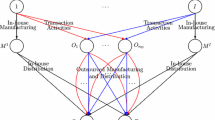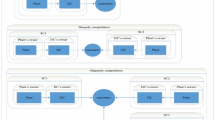Abstract
A single-commodity equilibrium model of a competitive supply chain network with direct marketing in the case of random demands associated with the demand.markets is developed. The network structure of the supply chain is identified and equilibrium conditions are derived. A finite-dimensional variational inequality.formulation is established. A revised Quasi-Newton Method is built to solve the equilibrium model with direct marketing under random demands, and a numerical example is given.
Access this chapter
Tax calculation will be finalised at checkout
Purchases are for personal use only
Preview
Unable to display preview. Download preview PDF.
Similar content being viewed by others
References
Stadtler H, Kilger C (2000) Supply chain management and advanced planning. Springer,Berlin.
Poirier C (1996) Supply chain optimization: Building a total business network. Berrett- Kochler Publishers, San Francisco.
Poirier C (1999) Advanced supply chain management: How to build a sustained competitive advantage. Berrett-Kochler Publishers, San Francisco.
Federgruen A, Zipkin P (1986) An inventory model with limited production capacity and uncertain demands I: The average cost criterion. Mathematics of Operations Research 11:193–207.
Slats P, Bhola B, Evers J et al (1995) Logistic chain modelling. European Journal of Operations Research 87:1–20.
Hensher D, Button K, Brewer S (2001) Handbook of logistics and supply chain management.Elsevier, Oxford.
Ereng¨uc S, Simpson N, Vakharia A (1999) Integrated production/distribution planning in supply chains: An invited review. European Journal of Operations Research 115:219–236.
Lee L, Billington C (1993) Material management in decentralized supply chains. Operations Research 41:835–847.
Anupindi R, Bassok Y (1996) Distribution channels, information systems and virtual centralization.In: Proceedings of the Manufacturing and Service Operations Management Society Conference 87–92.
Lederer P, Li L (1997) Pricing, production, scheduling, and delivery-time competition. Operations Research 4:407–420.
Corbett C, Karmarkar U (2001) Competition and structure serial supply chains with deterministic demand. Management Science 47:966–978.
Arrow K, Intrilligator M (1982) Handbook of mathematical economics. Elsevier, New York.
Nagurney A (1999) Network economics: A variational inequality approach. 2nd edn, Kluwer Academic Publishers, Dordrecht.
Nagurney A, Cruz J, Dong J et al (2005) Supply chain networks, electronic commerce, and supply side and demand side risk. European Journal of Operational Research 164:120–142.
Nagurney A, Dong J, Zhang D (2002) A supply chain network equilibrium model. Transportation Research Part E: Logistics and Transportation Review 38:281–303.
Nagurney A, Liu Z, Cojocaru M et al (2007) Dynamic electric power supply chains and transportation networks: An evolutionary variational inequality formulation. Transportation Research Part E: Logistics and Transportation Review 43:624–646.
Nagurney A, Matsypura D (2005) Global supply chain network dynamics with multicriteria decision-making under risk and uncertainty. Transportation Research Part E: Logistics and Transportation Review 41:585–612.
Nagurney A, Toyasaki F (2003) Supply chain supernetworks and environmental criteria.Transportation Research Part D: Transport and Environment 8:185–213.
Nagurney A (2006) On the relationship between supply chain and transportation network equilibria: A supernetwork equivalence with computations. Transportation Research Part E:Logistics and Transportation Review 42:293–316.
Fischer A (1992) A special Newton-type optimization method. Optimization 24:269–284.
Acknowledgements
The research was supported by the philosophy and Social Science Planning Projects of Sichuan Province (SC11B044), P. R. China; Bringing in qualified personnel projects of Chengdu University of Information Technology (KYTZ201203), P. R. China.51 The Supply Chain Network Equilibrium Model with Direct Marketing 615
Author information
Authors and Affiliations
Corresponding author
Editor information
Editors and Affiliations
Rights and permissions
Copyright information
© 2013 Springer-Verlag London
About this paper
Cite this paper
Wu, Z., Huang, B., Hu, Y. (2013). The Supply Chain Network Equilibrium Model with Direct Marketing under Random Demand. In: Xu, J., Yasinzai, M., Lev, B. (eds) Proceedings of the Sixth International Conference on Management Science and Engineering Management. Lecture Notes in Electrical Engineering, vol 185. Springer, London. https://doi.org/10.1007/978-1-4471-4600-1_51
Download citation
DOI: https://doi.org/10.1007/978-1-4471-4600-1_51
Published:
Publisher Name: Springer, London
Print ISBN: 978-1-4471-4599-8
Online ISBN: 978-1-4471-4600-1
eBook Packages: EngineeringEngineering (R0)




